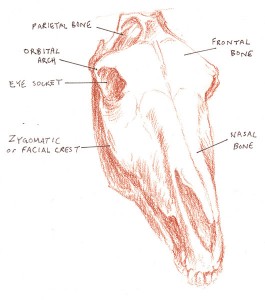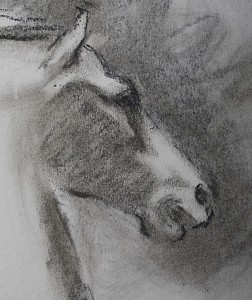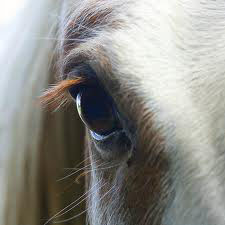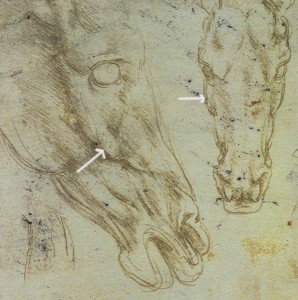How to draw horse eyes, part 1
September 10, 2012
General structure and position of horse eyes
Above: Leonardo da Vinci’s “Studies of horses’ heads” c.1481, metalpoint
Introduction
This post is the first of a short series on “how to draw horse eyes”. Instead of giving you step-by-step instructions on copying a horse eye, I shall provide plenty of tips and ideas that you can apply to your own horse drawings.
The first thing to get right when drawing a horse’s eye is to position it correctly on the head. However adept you are at getting the eye detail correct, the picture will not look convincing if the eye is poorly positioned. Today I discuss the basics of eye shape and position. In part 2, I shall explain the close-up view of the eye and lids in more detail. In part 3, I shall discuss horse eye expression.
From a little distance away, the eye appears as a shadowy form within the head, and it is the general shape of this that is most important. Here I have scribbled a couple of charcoal sketches of horse heads to show how a dark tonal shape in the right place can by understood as a reasonably convincing eye within the head:
Eye “globe” surrounded by eyelids
The eye itself (the “globe”) is almost spherical. The surface of this sphere forms a rounded dome between the eyelids. Here is a close-up photo showing the front view of a horse’s eye. I hope that you can appreciate the roundness of the eye globe from this picture:
Horse head anatomy, showing eye position
I have drawn two diagrams of the horse’s head to help to illustrate how the eye is positioned. The first is a three-quarter view of the horse’s skull:
 Note, in the diagram above, the rather rounded eye socket (hole) . The eye fits into this socket.
Note, in the diagram above, the rather rounded eye socket (hole) . The eye fits into this socket.
See how the bony rim around the eye socket juts out more above the eye than below it. This can throw the eye itself into shadow in many lighting conditions.
Notice how the “orbital arch” juts out to the side of the head. In fact, this orbital arch (the further-back part of the bony rim of the orbit) is usually the widest point of the horse’s head.
The second view includes the eye itself and some muscles:
The eyelids form an almond-shaped opening for the eye.
That almond shape is angled in relation to the horse’s head. The furthest-back part of the eye juts out to the side.
The furthest-forward part of the eye is often called the inner corner of the eye. This is equivalent to the inner corner of your own eye, where tears emerge. This far-forward part of the eye is tucked in towards the midline of the head. My blue arrow on the photo, below, shows how the eye angles from out to in:
Leonardo da Vinci’s frontal study of a horse head also shows how the eye angles from out to in:
And here is an almost- frontal photo of a horse head. Again, the slant of the eye from out to in is apparent. Also notice how the upper eyelid juts out to some extent and overhangs the eye. The upper eyelashes are very prominent and really overhang the eye. The lower lid does not jut out to the side.
What structures surround the eye?
The facial crest is the prominent ridge of bone on either side of the head. It runs below, and extends in front of, the eye. I have marked it onto Leonardo da Vinci’s drawing below. See how the eye is angled relative to the facial crest on the side and front view:
The muscles above the eye form an upside-down V or C-shaped “eyebrow”. The shape of this brow changes with expression and mood, and I shall discuss that further in part 3 of this series within the next few weeks.
In the above photo, I have marked the eyebrow with a red arrow.
The temporal fossa is marked with a blue arrow. This is a hollow depression above and behind the eye. It is more hollow in some breeds including Arabian horses, and also in old or lean horses.
The zygomatic arch is marked with a yellow arrow. This is a ridge of bone extending back from the eye.
Here is another study by Leonardo da Vinci showing the position and slope of the eye in relation to other structures on the head.
Above: Leonardo da Vinci, detail from “Study of a horse and rider”, Metalpoint, c.1481
Summary
The position of the eye is very important.
The eye itself is a round globe shape that domes out between the eyelids.
The opening between the eyelids is shaped rather like an almond.
The eyelid opening is set at an angle. It slopes from out (further back) to in (further forward).
The upper eyelid juts out much more than the lower lid.
The eyebrow forms an upside-down C or V shape above the eye.
Remember to check back here for the next two parts of this series on drawing horse eyes. I shall discuss the close-up appearance of the eye, lids, lashes, etc. in more detail next time. The third post will be on how eye appearance changes with horse expression.











I like of The explanation I wil follow the steps
Thank you for this so so helpful information I have searched everywhere in my previous 10 years as a horse artist and am in the process of writing my own e course on Drawing the Horse’s Head to increase my own understanding as much as anything. In depth on skull, features and muscles. I have worked out the skeletal underpinnings of the eye from my own horse skull and ditto also for the eyeball, eyelids and orbital muscle, but this is so helpful on the subtle angles.